Starry Jackets and Sneak Peeks: Interview with Sharon Lee & Steve Miller (Part One)
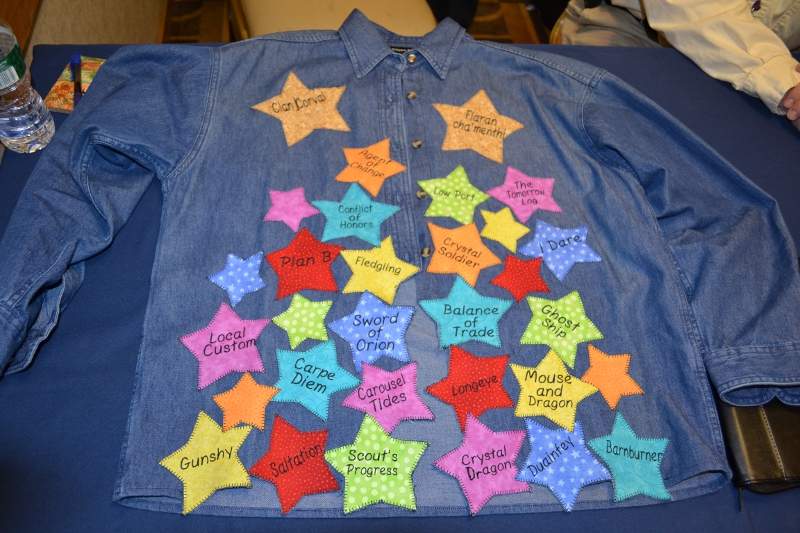
At PortConMaine, we interviewed Sharon Lee and Steve Miller, the lovely and gracious authors of the Liaden Universe novels and stories, among other works. Sharon (sporting the Starry Jacket of Many Titles) and Steve spent about half an hour with us discussing their work, and upcoming projects. The transcript of the first portion of the interview appears below. The second half of the transcript, and video footage are forthcoming.
During our walkabout through the Con, we spotted Sharon reading, but actually recognized her by the fabled jacket pictured below!
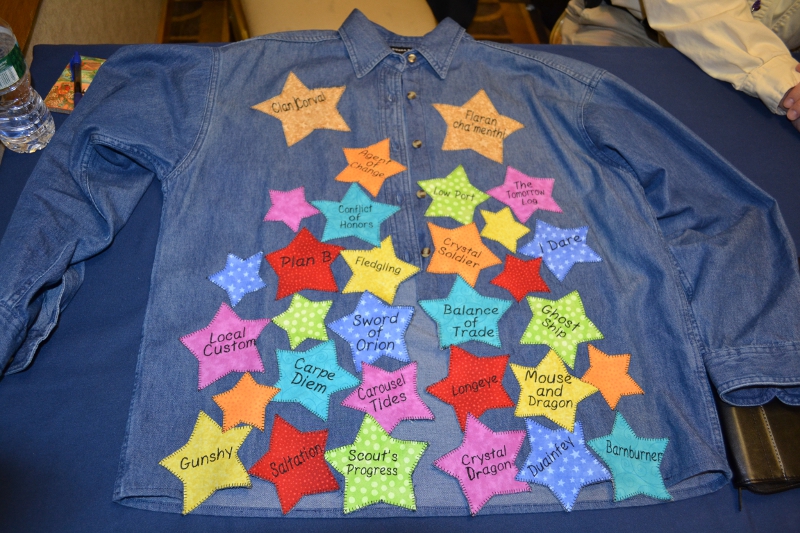
All right. Here we are, this is Nerd Caliber, and we’re interviewing Steve Miller and Sharon Lee, the [authors] of the Liaden Universe books. Talk to us about how your writing partnership works: do you – one of you – concentrate on the characters, and one on the plot? Do you share everything? How does that work?
[Lee and Miller chuckle]
Miller: We’re smiling because we have a standard joke of ‘Sharon does –
Lee: Yeah, I write the adjectives and he does the nouns. [laughs]
Miller: However, the way it usually works is that one of us will have a project in mind, a story or short story, and suggest it to the other, and that person generally gets to do the first rough of it, and then we go from there, once the story is under way, once we’ve decided that’s how we’re going to be doing things.
Lee: The other thing that we do is that we role play. Because there are two of us, so nobody looks at you funny because you’re talking to yourself. We play out the story, we play out the character, we make noises, we bang on the table, we do all kinds of other things. We clog up the grocery aisle and our neighbors have to walk around – ‘Sharon, Steve. Working?’ [Laughs] So that’s basically what we do, and since we have no children (we have cats) anything – anything in the house stops when one of us says ‘story stuff – I just had an idea.’
Miller: Occasionally when we have very rough spots, and this was – this is off-putting to people when we explain it if they’re in California or something, but here it’s a little better known, is that we’ll get in the car sometimes and just talk stories out. We’ve been known to get up in the morning and say ‘Eh, this is not working, let’s go to breakfast,’ and so then we end up in Canada. And we’ve done that on a number of occasions. Of course it’s easy enough here. We live closer to Canada than we do to the United States, in effect, by where we are in Maine. And that’s another thing to do, we’ll just sit and let the world go by while we’re discussing who/what/where/when and how.
Lee: The other thing that we do – Steve mentioned that the person who comes up with the story is the “gatekeeper” and gets to do the first draft: they also get a third vote. Because there are two of us, we can get tied sometimes, if we don’t agree on where the story’s going or how the character is acting. That said, when things are stalled, we can usually argue out by way of ‘How would the character handle this?’ Because the stories have to be for the character, of the characters, the characters have to be true. We have only twice in – eighteen novels? Eighteen novels, I think it is [Miller nods] – hit a point where the tie had to be – where the tie had to be invoked. Once was Steve, when I had been writing the first draft for Carpe Diem and I had killed two characters. And I killed them quickly and painlessly, or as painlessly as possible, but I felt that they were in a situation where they needed to die – their spaceship had been hulled. And Steve got the draft to go through, for the second draft, and said ‘No, no, no, we’re going to need these characters!’ and I said, ‘Well that’s fine, you can bring them back to life, but if anybody calls you on it, you’re gonna have to write the short story that tells everybody how they survived.’ And he got away with it for fifteen years. [both chuckle]Now I’m trying to remember in Carpe Diem who it was!
Lee: There you go!
[laughs] That might take me a little while.
Lee: And the other tie-breaking situation was for Plan B.
Miller: Yes.
Lee:And I had pulled – I pulled a chapter because I felt that it slowed down the action. And I talked to Steve about it, went ‘mmmmm,’ Steve’s like, ‘No, I think it needs to stay in there,’ and I thought about it, slept on it, came back, read it, said ‘No, it’s gotta go.’ Pulled the chapter, and since I was the gatekeeper on that one, it went. About that time, we had a fan, a long-time writer, a woman named Anne McCaffrey, she lives in Ireland. And she had written me an email, and said, ‘What are you guys working on?’ And I said, ‘Well, we just finished a book.’ And she said ‘Oh! Can you email it to me?’ Like, no, I’m not going to. So I said ‘sure’ and I attached it and sent it off, got up the next morning, there’s an email from Anne saying ‘ I read it! It’s great! I love this book, but there’s a chapter missing! And she told me where. [Miller laughs]
Oh wow.
Lee: And I said, ‘Well yes, there is a chapter missing, but I pulled it to make weight.’ And she said, ‘Send it to me.’ So I said ‘ok,’ sent it to her, went down, made coffee, came back, email from Anne! And I don’t know what time in the morning it is in Ireland, and the email consists of ‘Put. It. Back.’ [Miller laughs] So we did that. [laughs]
Miller: So that’s one of the ways we work. A lot of the – a lot of our ability to do this comes from the background we both have of collaboration in newspaper situations, because we’ve both worked for newspapers, we’ve both done editorial for newspapers and for PR, that kind of thing. We both have done some TV commercials, which – there’s nothing that’s more collaborative [Lee laughs] than a TV commercial because everybody gets to tell you, and gets their fingers in the pie.
Lee: The client, the creative director, the – yeah.
Miller: So you get used to working for the project, rather than to seeing ownership. The project is the owner, not the individual.
Just to do my homework, I was reading on your blog this morning that you guys are converting a lot of your chapbooks into ebooks through Smash[words], and tell us about how that works, and where those will then be available.
Lee: Ok, almost all of them! As a matter of fact, all of the chapbooks! All of the chapbooks are up at Barnes & Noble in the Nook store, at Amazon in the Kindle store, and at Smashwords where you can buy them in 15,000 kinds of formats. So, they’re easy to get to. The only book which needs to be uploaded – electrified and uploaded – right now is The Tomorrow Log, which is a non-Liaden space opera novel, which I’m saving for dessert. [laughs]
Miller: What we’ve actually done is, we’ve created another imprint for ourselves, and it’s pinbeambooks.com, and Pinbeam Books acts as the publisher. We already owned, in a way that most people don’t – some people have dolls sitting around – we had ISBNs sitting around, ISBN numbers. We had – on one of our other projects we had bought a thousand, so we had some ISBNs that we could assign to it, and that worked out quite well, so Pinbeam Books is officially the publisher, not Sharon, not me, and that allows us to go through Kindle, and Nook. And Smashwords, because we’re seen as a publisher, can then pass them on through their – what’s it called – it’s a premier –
Lee: Premier catalog.
Miller: – catalog, and that means people who’ve got Apple iPads will be able to download that through the Apple store, which Smashwords pushes to. People who want to be able to print the book out, Smashwords has an option for that, as well. So there’s a number of things that go through – a lot of people don’t like to do Smashwords, they want to be able to just get on, on their Kindle or their Nook, and say ‘Just give it to me now!’ and that’s the advantage there. And that’s why we started out with them and slowly are moving towards the Smashwords.
Well, I think I know a little bit of the answer to this, but how do you feel about digital publishing, [Lee and Miller laugh] versus traditional.
Miller: I’ll take that first.
Lee: Yup.
Miller: Back in the dark ages of 1988 and ‘89, we were already doing ebooks, as b-plan virtuals. We saw some examples, we thought it was a good idea. Along the way, we were among the first people to get ripped off by somebody copying those books, even though they’d had some DRMs, some digital rights management. Along – we gave up after, as Sharon puts it, we didn’t lose both our shirts, we only lost my shirt, doing that. Later on, in the early 2000s, we were part of Embiid. And Embiid, we were with Embiid, doing ebooks, and we were trying to convince them to let us do non-DRM books because everybody at that time was being so – so rigid about it. And that didn’t work out, they went out of business before they tried the non-DRM, and I think it might have done well for them. In general, the digital books, we think, are lovely. They’re useful. Sharon has – how many books do you have with you right now?
Lee: Oh, I think I only have 25. On – I was reading my ‘book’ when you – when you found me in the lobby.
Well, I have to tell you, and I’m sure this will please you, I have your three ARCs, through baen.com. I have Fledgling, Saltation, and Ghost Ship, with me, actually, and that was part of my homework as well for this interview. But I was excited to see, on your blog, that you’re working on another book in that series about Theo Waitley, Dragon Ship. Can you tell us anything about that?Miller: No. [Lee and Miller laugh] Actually, Dragon Ship is moving along. For our regular readers, it would be unfair to go into too much of what’s going on. The general overview is that Theo Waitley, when we began the series – which was another digital situation because we – Fledgling first appeared on the web every week as a serial, and then so did Saltation, which was the follow-on book. Ghost Ship was a more complex book. The first two were able to be done episodically, we could do them chapter after chapter as Theo grew. And Theo, when she started was a – I don’t want to say ignorant, but she was a naive young schoolgirl in a world that kept people safe. And then she had to grow through that, and went through a series of adventures and growth periods. Ghost Ship deals with a complex background. It melds the entire rest of the Liaden universe in, and they all move in together and drew in together. And that will be coming out –
Lee: August second.
Miller: August second, that will be officially out in paper, and that’s done. So, Dragon Ship will then take all of those series – the books that feed into it are not only Fledgling and Saltation but also –
Lee: I Dare.
Miller: I Dare and Mouse & Dragon. All of them feed into what’s happening in Dragon Ship, which meant I had to go reread about fourteen books before I was able to go ahead and move into it. But that’s about what I can say. Theo moves on, and her good friend Ship Bechimo, moves on in Dragon Ship.
Well, that’s very exciting! I’m definitely looking forward to that.
TO BE CONTINUED…

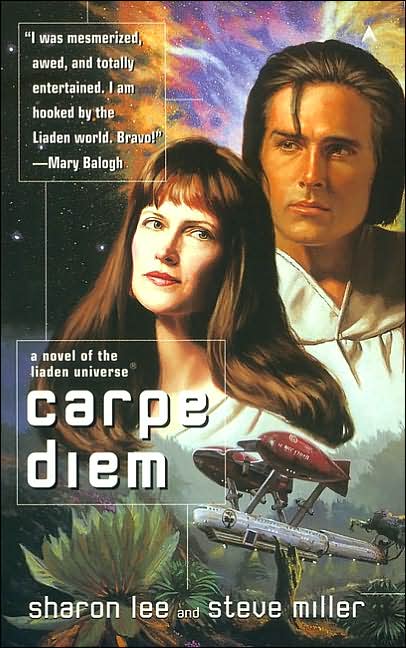


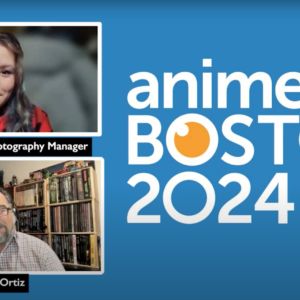

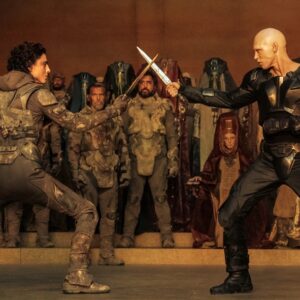
Thank you ever so for you article post. Great.
I just now wanted to thank you again for your amazing web page you have designed here. It’s full of useful tips for those who are genuinely interested in that subject, primarily this very post. You’re really all absolutely sweet as well as thoughtful of others as well as reading your blog posts is a wonderful delight if you ask me. And that of a generous present! Ben and I really have fun making use of your guidelines in what we should do in the future. Our list is a distance long and tips might be put to great use.